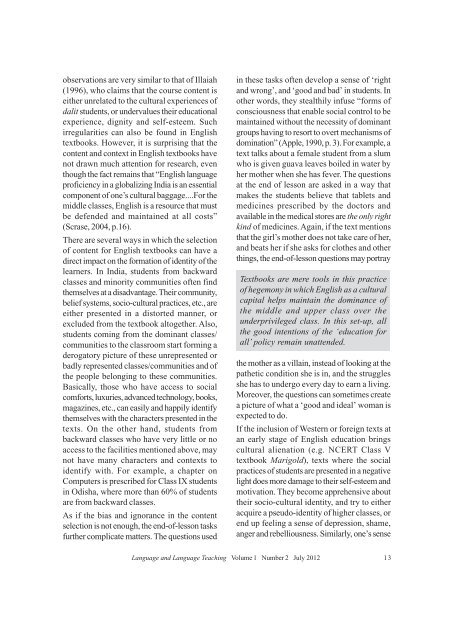Language and Language Teaching, Issue 2 - Azim Premji Foundation
Language and Language Teaching, Issue 2 - Azim Premji Foundation
Language and Language Teaching, Issue 2 - Azim Premji Foundation
Create successful ePaper yourself
Turn your PDF publications into a flip-book with our unique Google optimized e-Paper software.
observations are very similar to that of Illaiah(1996), who claims that the course content iseither unrelated to the cultural experiences ofdalit students, or undervalues their educationalexperience, dignity <strong>and</strong> self-esteem. Suchirregularities can also be found in Englishtextbooks. However, it is surprising that thecontent <strong>and</strong> context in English textbooks havenot drawn much attention for research, eventhough the fact remains that “English languageproficiency in a globalizing India is an essentialcomponent of one’s cultural baggage....For themiddle classes, English is a resource that mustbe defended <strong>and</strong> maintained at all costs”(Scrase, 2004, p.16).There are several ways in which the selectionof content for English textbooks can have adirect impact on the formation of identity of thelearners. In India, students from backwardclasses <strong>and</strong> minority communities often findthemselves at a disadvantage. Their community,belief systems, socio-cultural practices, etc., areeither presented in a distorted manner, orexcluded from the textbook altogether. Also,students coming from the dominant classes/communities to the classroom start forming aderogatory picture of these unrepresented orbadly represented classes/communities <strong>and</strong> ofthe people belonging to these communities.Basically, those who have access to socialcomforts, luxuries, advanced technology, books,magazines, etc., can easily <strong>and</strong> happily identifythemselves with the characters presented in thetexts. On the other h<strong>and</strong>, students frombackward classes who have very little or noaccess to the facilities mentioned above, maynot have many characters <strong>and</strong> contexts toidentify with. For example, a chapter onComputers is prescribed for Class IX studentsin Odisha, where more than 60% of studentsare from backward classes.As if the bias <strong>and</strong> ignorance in the contentselection is not enough, the end-of-lesson tasksfurther complicate matters. The questions usedin these tasks often develop a sense of ‘right<strong>and</strong> wrong’, <strong>and</strong> ‘good <strong>and</strong> bad’ in students. Inother words, they stealthily infuse “forms ofconsciousness that enable social control to bemaintained without the necessity of dominantgroups having to resort to overt mechanisms ofdomination” (Apple, 1990, p. 3). For example, atext talks about a female student from a slumwho is given guava leaves boiled in water byher mother when she has fever. The questionsat the end of lesson are asked in a way thatmakes the students believe that tablets <strong>and</strong>medicines prescribed by the doctors <strong>and</strong>available in the medical stores are the only rightkind of medicines. Again, if the text mentionsthat the girl’s mother does not take care of her,<strong>and</strong> beats her if she asks for clothes <strong>and</strong> otherthings, the end-of-lesson questions may portrayTextbooks are mere tools in this practiceof hegemony in which English as a culturalcapital helps maintain the dominance ofthe middle <strong>and</strong> upper class over theunderprivileged class. In this set-up, allthe good intentions of the ‘education forall’ policy remain unattended.the mother as a villain, instead of looking at thepathetic condition she is in, <strong>and</strong> the strugglesshe has to undergo every day to earn a living.Moreover, the questions can sometimes createa picture of what a ‘good <strong>and</strong> ideal’ woman isexpected to do.If the inclusion of Western or foreign texts atan early stage of English education bringscultural alienation (e.g. NCERT Class Vtextbook Marigold), texts where the socialpractices of students are presented in a negativelight does more damage to their self-esteem <strong>and</strong>motivation. They become apprehensive abouttheir socio-cultural identity, <strong>and</strong> try to eitheracquire a pseudo-identity of higher classes, orend up feeling a sense of depression, shame,anger <strong>and</strong> rebelliousness. Similarly, one’s sense<strong>Language</strong> <strong>and</strong> <strong>Language</strong> <strong>Teaching</strong> Volume 1 Number 2 July 2012 13
















